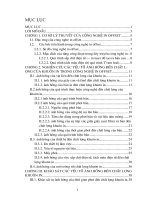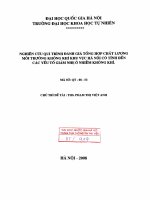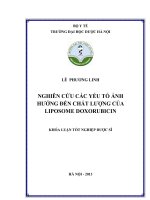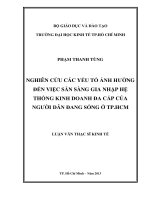Nghiên cứu chất lượng sống ở người nhiễm HIV và phân tích đa mức độ các yếu tố ảnh hưởng _Quality of Life among HIVAIDS and Multilevel Analysis on influencing Factors in west of China
Bạn đang xem bản rút gọn của tài liệu. Xem và tải ngay bản đầy đủ của tài liệu tại đây (105.99 KB, 13 trang )
QUALITY OF LIFE AMONG
HIV/AIDS AND MULTILEVEL
ANALYSIS ON INFLUENCING
FACTORS IN WEST OF CHINA
1 School of public health
Kunming Medical University
2 Yunnan Provincial Collaborative Innovation Center for
Public Health and Disease Prevention and Control
Wenlong CUI
2015-9-26
Backgroud
Method
Assessment
Results
Discussion
of QoL
BACKGROUD
HIV/AIDS is one of the most devastating
illnesses that humans have ever faced.
HIV infection and AIDS patients are especially
dependent on illegal drug use, and HIV/AIDS
is very prominent in YUNNAN.
Quality of life (QoL) is particularly relevant in
research involving patients with acquired
immune deficiency syndrome (AIDS).
METHOD
Study area and population
From January 2011 to March 2011, cross-sectional
surveys were conducted in these three cities,
Longchuan in Dehong, Gejiu in Honghe and Kunming.
METHOD
Data collection and measurement
Each participant who gave informed consent was
personally interviewed by one of the interviewers using
a pre-tested and structured questionnaire.
Trained investigators from the Kunming Medical
University conducted face-to-face interviews with
patients with the support of staff at their local Center for
Disease Control and Prevention (CDC).
With an overall response rate of 94.18%, we conducted
full interviews with a total of 503 participants: 245 in
Kunming city, 158 in Gejiu city, and 113 in Longchuan
city.
ASSESSMENT OF QOL
QoL
was evaluated using a 35-item,
simplified Chinese, simplified version of
the Medical Outcomes Study HIV Health
Survey (MOS-HIV) questionnaire.
The
simplified Chinese version of the
MOS-HIV questionnaire has previously
been demonstrated to have good
reliability and validity.
ASSESSMENT OF QOL
The MOS-HIV measures 10 domains, including 8
multi-item domains (general health, physical
function, role function, cognitive function, pain,
mental health, energy/fatigue, and health distress)
and 2 single-item domains (social function and
QoL).
Two summary scores, namely the physical health
summary (PHS) score and mental health summary
(MHS) score, were generated from the factor
analysis of the 10 scales.
RESULTS
Table 1 Demographic characteristics of the study
population
Characteristics
HIV
AIDS
No. persons
Percentage
No. persons
Percentage
Age group
18-39
242
61.6
63
57.3
≥40
151
38.4
47
42.7
Ethnicity (%)
Han
272
69.2
84
76.4
Minority
121
30.8
26
23.6
Gender
female
146
75.6
47
24.4
male
247
79.7
63
20.3
RESULTS
Table 2 QOL of HIV and AIDS on the study
population
HIV
AIDS
P Value
general health
44.83±23.95
35.81±23.57
0.001
physical function
81.99±21.15
69.39±27.35
0.000
role function
62.98±46.40
39.54±46.97
0.000
cognitive function
71.95±24.65
63.27±29.39
0.000
pain
80.83±26.08
72.32±30.90
0.009
mental health
63.51±22.47
58.69±22.13
0.047
energy/fatigue
51.51±24.15
44.59±23.74
0.008
health distress
74.55±21.66
67.64±24.60
0.008
social function
74.20±32.56
60.91±35.41
0.000
QoL
50.95±20.22
48.86±23.06
0.390
RESULTS
Table 4 95% CI for multilevel logistic regression
analysis of PHS and MHS in HIV responders
Predictors
(Constant)
Income level
Work status
PHS Score
MHS Score
54.020(46.240, 61.800)
51.703(42.634, 60.771)
2.834*(.276, 5.392)
1.561(-1.003, 4.125)
-3.331**(-5.463, -1.198)
-.878(-2.984, 1.229)
3.412**(1.278, 5.545)
2.146*(.032, 4.259)
1.283(-.772, 3.338)
2.574*(.544, 4.605)
-2.169*(-4.239, -.099)
-6.230**(-8.279, -4.181)
-6.133**(-9.574,-2.692 )
-5.429**(-8.840, -2.018)
-4.339**(-6.426, -2.252)
-2.351*(-4.408,-.295 )
Subjective Support
Use of support
Gender
route of infection
Age group
(*p<0.05, **p<0.01)
DISCUSSION
Among the annually reported new HIV infections, the
ratio of men to women decreased from 5:1 in 1990s to
2.3:1 in 2009. The proportion of females living with HIV
increased from 15.5% to 40.3% in Yunnan.
Results show that the PHS and MHS scores were lower
for patients infected from drug use than those infected
from sexual contact.
CONCLUSION
Females who acquired the disease from heterosexual
transmission had a better QoL than males and drug
users.









